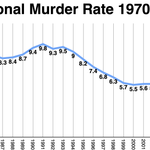

State and regional murder statistics show no correlation between use of the death penalty and reduced crime.
The foundation for the death penalty in the U.S. rests on whether it is necessary as a response to murder. About 40 percent of the states have ended the use of capital punishment. Of the remaining states that retain it, only a few use it on a regular basis. The murder rates of states with and without the death penalty are relevant to whether it is justified. The murder rate for the country as a whole over various time periods is also a barometer of whether or not the public will be in favor of harsher punishments for crime. Murder rates, which are the result of dividing the number of murders by the population of a jurisdiction, can be more useful in comparing states and countries than the absolute number of murders committed.
In trying to measure whether the use of the death penalty has an effect on the level of violent crime, researchers often use murder rates and compare them with the practice of the death penalty, either through the number of executions or death sentences. This is problematic on a national basis because the death penalty is not available in many states, and where it is carried out, the executions amount to only a tiny percentage of the murders committed. Even when comparing states, it is difficult to single out whether the relatively rare use of the death penalty is causing a change in crime or whether the change is attributable to other causes such as the rate of employment, the quality of education, or many other local variables.
DPIC has collected statistics published by the FBI on the murder rates in each state for each year, each geographical region, and for the country as a whole. DPIC deepens the analysis by noting whether each state had the death penalty for the time period in question. Murder rates can easily be compared with other available data, such as the number of executions, death sentences, and the size of death row.
